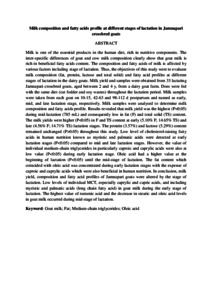Citation
Zailan, Mohamad Zaihan and Yaakub, Halimatun
(2018)
Milk composition and fatty acids profile at different stages of lactation in Jamnapari crossbred goats.
Malaysian Journal of Animal Science, 21 (2).
109 - 122.
ISSN 1394-3227; ESSN: 2550-2123
Abstract
Milk is one of the essential products in the human diet, rich in nutritive components. The inter-specific differences of goat and cow milk composition clearly show that goat milk is rich in beneficial fatty acids content. The composition and fatty acids of milk is affected by various factors including stage of lactation. Thus, the objectives of this study were to evaluate milk composition (fat, protein, lactose and total solid) and fatty acid profiles at different stages of lactation in the dairy goats. Milk yield and samples were obtained from 33 lactating Jamnapari crossbred goats, aged between 2 and 4 y, from a dairy goat farm. Does were fed with the same diet (cut fodder and soy wastes) throughout the lactation period. Milk samples were taken from each goat on 10-15, 42-63 and 98-112 d postpartum and named as early, mid, and late lactation stage, respectively. Milk samples were analysed to determine milk composition and fatty acids profile. Results revealed that milk yield was the highest (P<0.05) during mid-lactation (785 mL) and consequently low in fat (F) and total solid (TS) content. The milk yields were higher (P<0.05) in F and TS content at early (5.10% F; 14.65% TS) and late (4.56% F; 14.71% TS) lactation stages. The protein (3.57%) and lactose (5.29%) content remained unchanged (P>0.05) throughout this study. Low level of cholesterol-raising fatty acids in human nutrition known as myristic and palmatic acids were detected at early lactation stages (P<0.05) compared to mid and late lactation stages. However, the value of individual medium-chain triglycerides in particularly caproic and caprylic acids were also at low value (P<0.05) during early lactation stage. Oleic acid had a higher value at the beginning of lactation (P<0.05) until the mid-stage of lactation. The fat content which coincided with oleic acid was concentrated during early lactation stages with the expense of caproic and caprylic acids which were also beneficial in human nutrition. In conclusion, milk yield, composition and fatty acid profiles of Jamnapari goats were altered by the stage of lactation. Low levels of individual MCT, especially caprylic and capric acids, and including myristic and palmatic acids (long chain fatty acid) in goat milk during the early stage of lactation. The highest value of rumenic acid and the decrease in stearic and oleic acid levels in goat milk occurred during mid-stage of lactation.
Download File
![[img]](http://psasir.upm.edu.my/74983/1.hassmallThumbnailVersion/Milk%20composition%20and%20fatty%20acids%20profile%20at%20different%20stages%20of%20lactation%20in%20Jamnapari%20crossbred%20goats%20.pdf)  Preview |
|
Text
Milk composition and fatty acids profile at different stages of lactation in Jamnapari crossbred goats .pdf
Download (93kB)
| Preview
|
|
Additional Metadata
Actions (login required)
 |
View Item |

